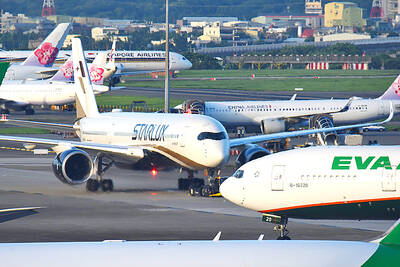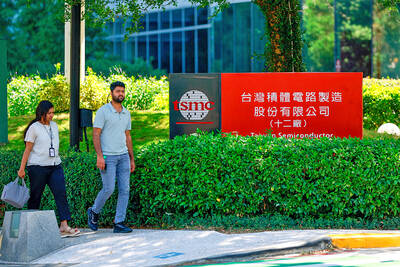Passive components supplier Walsin Technology Corp (華新科技) yesterday saw its shares rally 8.28 percent on expectations that expanding applications from smartphones to cars would extend a supply crunch.
Shares of Walsin have more than tripled since the beginning of this year, closing at NT$340 in Taipei trading, as the company benefits from rising prices and better profitability.
“We are seeing explosive growth in passive component demand, which should fuel Walsin’s revenue growth this year and next year, as already reflected in the past few quarters,” Walsin president Ku Li-chin (顧立荊) told investors on Thursday.
The company has clear order visibility through the end of this year, Ku said.
Walsin is expanding capacity to resolve a supply-demand imbalance, but it still cannot fully satisfy customers’ demand due to longer equipment lead time, he said.
“Some might ask when the supply constraint would end? I do not have the answer,” Ku said. “I have yet to set the light at the end of the tunnel.”
Ku said the company’s capacity would increase 10 to 20 percent by the second half of this year and revenue growth would be bolstered by price increases.
Prices have been trending upward, because passive components have been undervalued in the past 20 years and no significant capacity expansion has been made, he said.
As passive component costs account for less than 1 percent of an iPhone’s retail price, Ku said Walsin is looking for more reasonable pricing to enable it to recover manufacturing equipment investments within two to three years.
Walsin’s gross margin jumped to 35.8 percent last quarter from 22.8 percent a year earlier, while revenue swelled 42.8 percent to NT$6.64 billion (US$22.17 million) from NT$4.65 billion.
Net profit soared 230 percent annually to an all-time high of NT$1.31 billion, or earnings per share of NT$2.71, company data showed.
Demand for chip resistors as well as multilayer-ceramic capacitors (MLCC) has surged due to widening applications, such as facial recognition for smartphones, advanced autopilot systems for cars and electric vehicles.
An iPhone X is equipped with 1,100 MLCCs, compared with 300 to 500 units in the first-generation iPhone, Ku said.
Vehicles, especially electric cars, are another big consumer of MLCCs, and should drive growth by 10 times over the next decade or so, he said.
An electric car is equipped with at least 10,000 passive components, compared with 1,000 for gas-fueled cars, the company said.
The arrival of 5G wireless connectivity in the second half of next year or early 2020 should trigger a new wave of smartphone replacement and passive component demand, Ku said.

RECYCLE: Taiwan would aid manufacturers in refining rare earths from discarded appliances, which would fit the nation’s circular economy goals, minister Kung said Taiwan would work with the US and Japan on a proposed cooperation initiative in response to Beijing’s newly announced rare earth export curbs, Minister of Economic Affairs Kung Ming-hsin (龔明鑫) said yesterday. China last week announced new restrictions requiring companies to obtain export licenses if their products contain more than 0.1 percent of Chinese-origin rare earths by value. US Secretary of the Treasury Scott Bessent on Wednesday responded by saying that Beijing was “unreliable” in its rare earths exports, adding that the US would “neither be commanded, nor controlled” by China, several media outlets reported. Japanese Minister of Finance Katsunobu Kato yesterday also

Taiwan’s rapidly aging population is fueling a sharp increase in homes occupied solely by elderly people, a trend that is reshaping the nation’s housing market and social fabric, real-estate brokers said yesterday. About 850,000 residences were occupied by elderly people in the first quarter, including 655,000 that housed only one resident, the Ministry of the Interior said. The figures have nearly doubled from a decade earlier, Great Home Realty Co (大家房屋) said, as people aged 65 and older now make up 20.8 percent of the population. “The so-called silver tsunami represents more than just a demographic shift — it could fundamentally redefine the

China Airlines Ltd (CAL, 中華航空) said it expects peak season effects in the fourth quarter to continue to boost demand for passenger flights and cargo services, after reporting its second-highest-ever September sales on Monday. The carrier said it posted NT$15.88 billion (US$517 million) in consolidated sales last month, trailing only September last year’s NT$16.01 billion. Last month, CAL generated NT$8.77 billion from its passenger flights and NT$5.37 billion from cargo services, it said. In the first nine months of this year, the carrier posted NT$154.93 billion in cumulative sales, up 2.62 percent from a year earlier, marking the second-highest level for the January-September

‘DRAMATIC AND POSITIVE’: AI growth would be better than it previously forecast and would stay robust even if the Chinese market became inaccessible for customers, it said Taiwan Semiconductor Manufacturing Co (TSMC, 台積電) yesterday raised its full-year revenue growth outlook after posting record profit for last quarter, despite growing market concern about an artificial intelligence (AI) bubble. The company said it expects revenue to expand about 35 percent year-on-year, driven mainly by faster-than-expected demand for leading-edge chips for AI applications. The world’s biggest contract chipmaker in July projected that revenue this year would expand about 30 percent in US dollar terms. The company also slightly hiked its capital expenditure for this year to US$40 billion to US$42 billion, compared with US$38 billion to US$42 billion it set previously. “AI demand actually